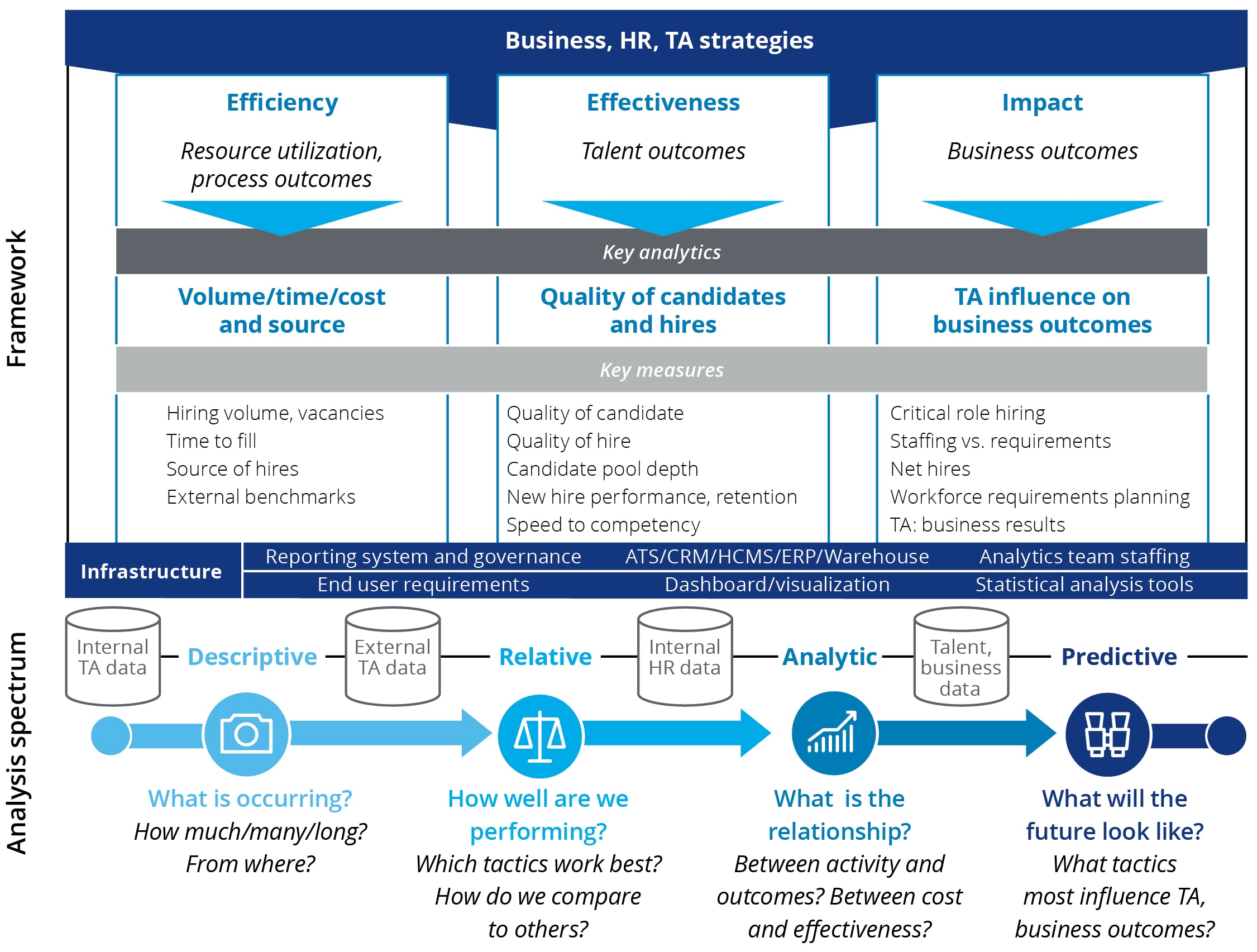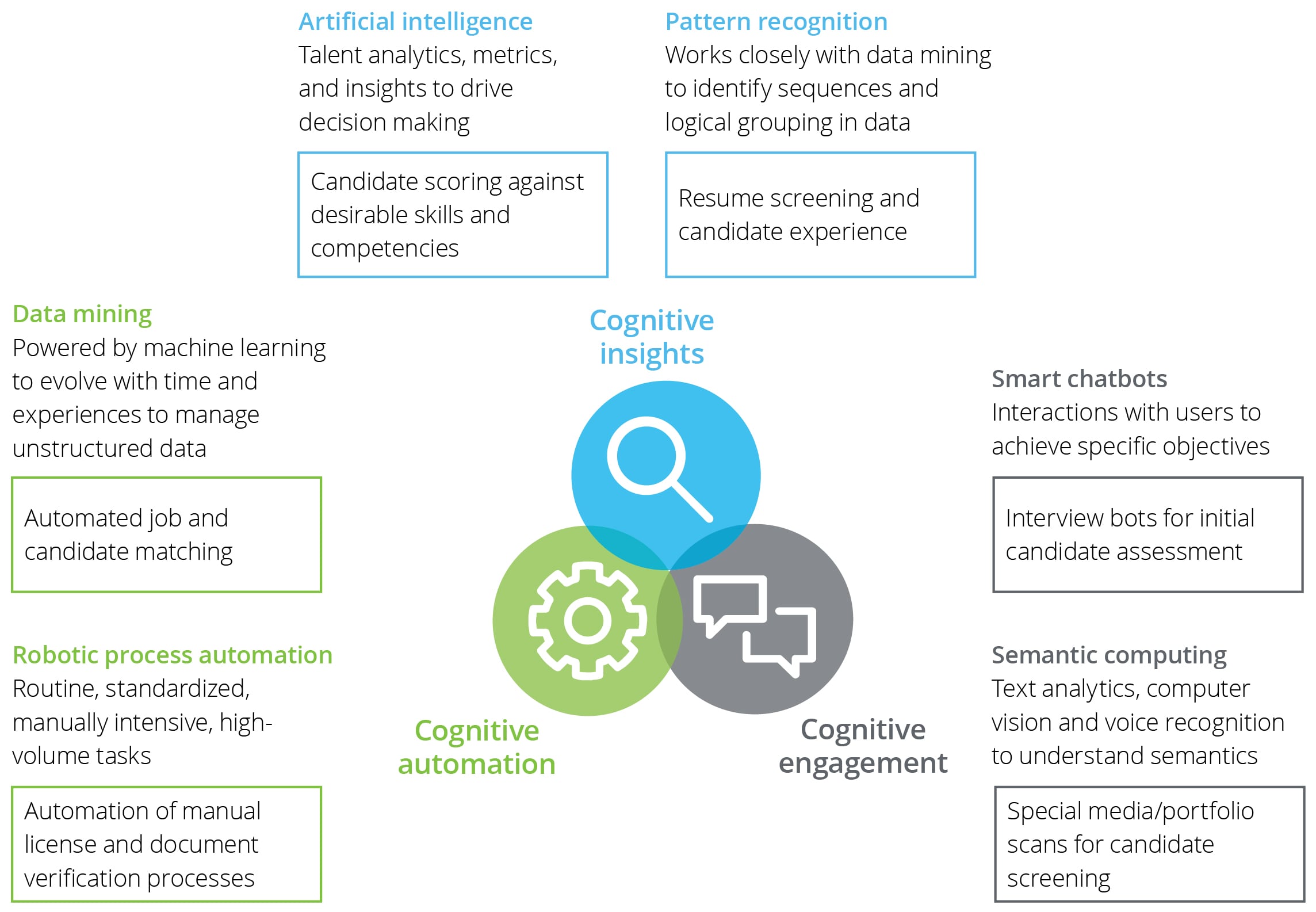Talent acquisition analytics has been saved

Analysis
Talent acquisition analytics
Using analytics for smarter sourcing and hiring decisions
The talent acquisition (TA) environment is becoming increasingly complex and competitive for organizations recruiting new talent. Data-driven approaches can deliver insights critical for improving operational and business outcomes. Whether it’s better awareness of candidate fit, process and technology optimization, or increased understanding of talent acquisitions impact on the business, analytics is a powerful force in the quest to source and hire top talent.
Explore content
- The challenge
- Why enhanced TA analytics matter
- A framework for defining leading recruiting analytics
- Analytic approaches
- A key consideration: Sources of data
The challenge
Employers have more pressure than ever to fill new jobs efficiently and effectively amid low unemployment and skilled labor shortages. The challenges multiply with the increased risk of talent movement—44 percent of millennial workers will be looking for a new job in two years, and are 25 percent more likely to search for a new job than non-millennials. With average new-hire turnover rates of 14 percent, a clear need exists for improved projects and insights into staging needs and strategies.
Our research found that 83 percent of 924 companies surveyed globally have low people analytics maturity, as compared to the high maturity organizations which have graduated to more advanced practices. The higher maturity organizations build consistent data definitions, use embedded reporting and analytical tools, and are building data integration capabilities to understand employee behaviors.
This indicates that most organizations are under-equipped to identify problem areas and potential solutions to their recruiting challenges. Addressing this capability gap is a business imperative, given the need to effectively manage
The opportunity: Why enhanced TA analytics matter
The impact of an advanced, high-maturity people analytics capability on business results is substantial, and enhancing it can increase the value of TA and the HR function to the business.
Considering the "whos" and "hows" of recruiting analytics impact not only helps stakeholders appreciate the value that using analytics for talent acquisition can bring to the organization but also helps guide your analytics approach and develop a roadmap for the journey.
The first step to closing the capability gap and increasing analytics maturity is to understand how talent acquisition analytics affects key stakeholders and what both they and the organization can gain from it. You should consider the outcomes stakeholders are driving toward, and the types of insights that will support achieving those outcomes.
A framework for defining leading recruiting analytics
"TA analytics" refers to the systematic discovery of meaningful patterns in data to support decision making related to recruitment and onboarding processes, activities, and outcomes. Three primary categories of measurement (efficiency, effectiveness, impact) are leveraged across four types of analysis (descriptive, relative, analytic, and predictive). As the framework progresses from left to right, the model increases in complexity of data used, systems tapped, and the sophistication of analytics techniques used. A robust infrastructure enables the analyses, with multiple data sources, repositories, analytic tools, staff capabilities, and visualization all focused on the business and information needs of the end users.
Analytic approaches
Each type of analysis offers valuable insights toward the overall success of the TA function, and is progressively more sophisticated in its nature. Leading organizations measure and report on all four metrics categories across the analysis spectrum, presenting reports and dashboards specific to the information needs of each end-user group.
Descriptive analysis
Provides a view into activity, such as requisition volume, applicant or talent pool size, source of hires, etc. It reveals the levels of activity and efficiency in candidate generation, and is a simple expression of volume, time, cost, or source.
Related analysis
Offers insights into TA performance against requirements or standards, including cost-per-hire, time-to-fill, pre-hire assessment scores, etc. It compares performance to budgets, tests, service level agreements (SLAs), or benchmarks, is represented as ratios or comparisons, and is critical to the efficient operation of the TA function.
Analytical analysis
Answers questions regarding the relationship between activities and outcomes, as in the quality of candidates or hires, skill match between candidates and position requirements, critical skill hire retention, speed to competency, etc. It uses basic statistics and multiple datasets to map TA activity to subsequent talent outcomes.
Predictive analysis
Identifies statistical relationships between multiple activities and outcomes to either:
- Predict what will happen in the future or to explain the drivers of that outcome, such as a candidate’s likely cultural fit, level of performance, and retention.
- Detect potential talent shortages/skills gaps, and market availability (workforce planning).
Predictive techniques also identify possible adjustments to TA strategies and the opportunity to deploy automation and/or contingent workforce solutions. These techniques leverage advanced statistical and modeling techniques with large, integrated datasets.
A key consideration: Sources of data
Leading companies no longer rely exclusively on the applicant tracking system (ATS) for reporting on transactional data. With the adoption of more advanced systems, data repositories, and analytics capabilities, the aperture expands to provide more integrated insights into the impact of TA processes and practices, including data from:
- Core HR, talent, learning, performance management and compensation systems for new-hire and high-performer demographic information and their influence on talent outcomes
- Skills inventories to identify skill surpluses and shortfalls within roles and geographies
- Candidate relationship management (CRM) systems for talent pool insights
- Social networks for passive candidate and employment brand strength insights
- Employee engagement surveys for evaluating new-hire satisfaction, retention risk, and hiring manager success
- Operational and financial systems (e.g., sales, enterprise resource planning (ERP)) for recruiting costs, and the impact of hiring activity on team, business unit, and/or corporate results
Data from these systems also shed light on the relative talent management value of sources of hire—both internal and external—for generating high performers, highly engaged employees, or future leaders within a critical role, line of business, geography, or diversity group.
Case in point
A global financial services organization sought an analytical approach to ensure that its future customer service workforce would be successful in a new organization model. A robust pre-hire analytics model was developed to predict employee success on the job. More than 6 million records were amassed using 12 internal and external data sources that spanned 70+ disparate files and contained 100+ data elements. The model validated that representatives in the highest predicted success group realized a 45 percent actual success rate versus 8 percent in the lowest predicted success group.
The future of talent acquisition analytics: Creating high impact and value with cognition
High-impact, high-value applications of using analytics for talent acquisition focuses on desired talent and business outcomes to provide actionable results. These enable robust decision support related to candidate selection, process design, budget/resource investments, and TA activity’s contribution to business objectives.
New advancements in cognitive technology are gaining a foothold in TA, creating opportunities for increased efficiency, accuracy, and insights. While these are advancing rapidly, the most ready-now solutions exist in candidate sourcing and screening and can potentially increase new-hire quality and reduce the impact of selection biases.
Getting started: How organizations can begin to upgrade
Moving beyond traditional analytics into an expanded range of insights starts with understanding the needs of your business and stakeholders—a valuable opportunity to improve their experiences and outcomes. To understand the most useful recruiting analytics, we recommend focusing on:
- Business strategies
- Decision support
- Benchmark measurements
In addition, include these infrastructure considerations when designing your delivery of new talent acquisition analytics:
- Data source integration
- Visualization
- Analytic capabilities
Analyzing these areas gives you a gauge of where you stand, where strategic opportunities lie, and what infrastructure components to target so you can begin to use analytics for talent acquisition and derive tangible insights and business value from your existing data.
Have questions about talent acquisition analytics? Contact us.




